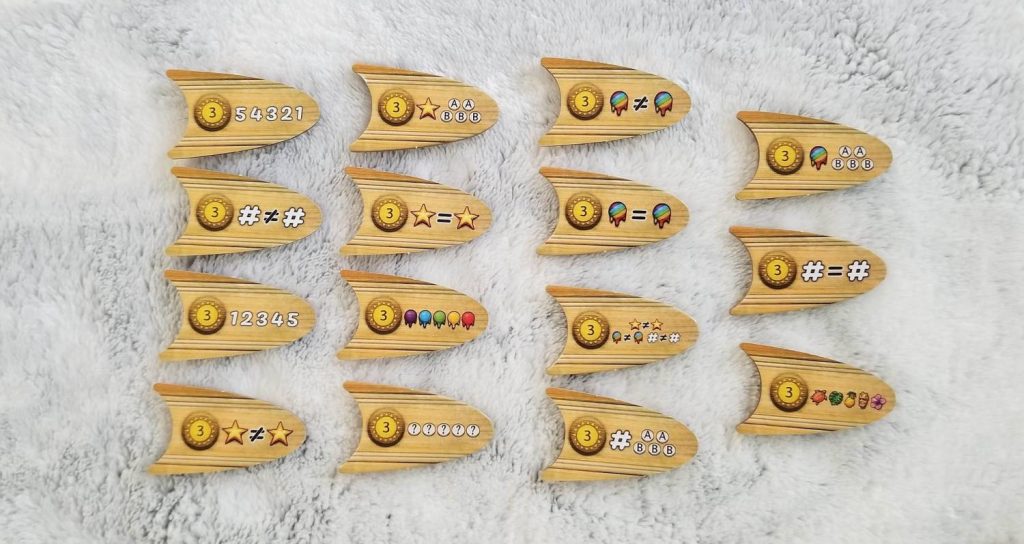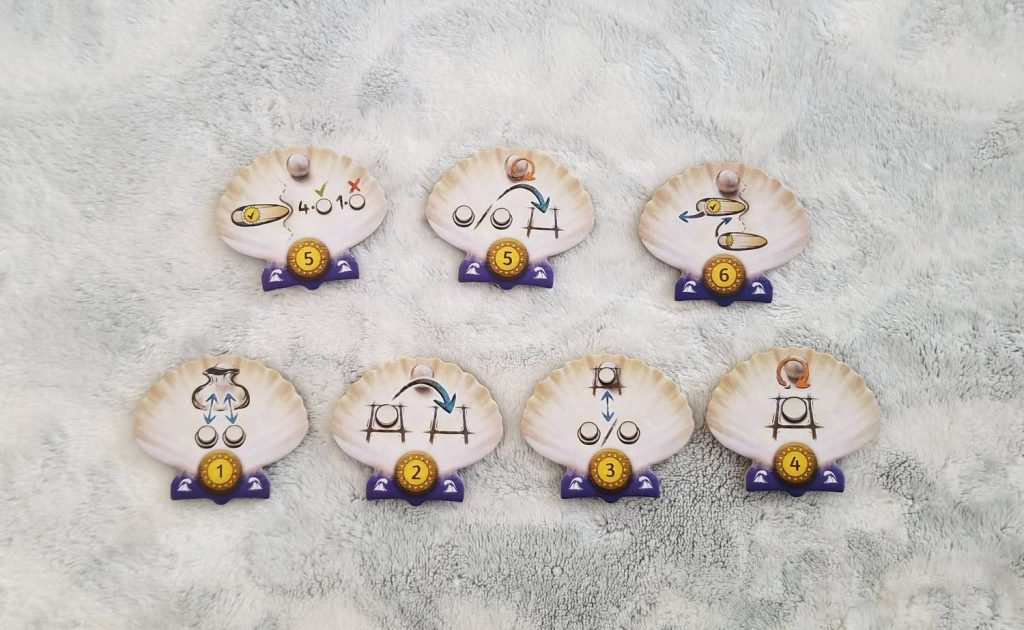Disclosure: Meeple Mountain received a free copy of this product in exchange for an honest, unbiased review. This review is not intended to be an endorsement.
From the mind of new designer Kosch (yep, that’s their full name) comes FYFE. It’s a hard game to pin down thematically, so I direct you to the description on the game’s BoardGameGeek page: “The cover of FYFE shows a dreamy South Seas location with a blue sea, beach, and palm trees — but what will you find as you dig in the sand, and can you arrange your discoveries in ideal scoring combinations?”
FYFE is played over 25 short rounds. As the game begins, each player is provided with a player board, a set of scoring criteria tiles, a set of seashell tiles, and two wooden tokens that are randomly drawn from a bag of tokens. Each token features an item, a color, and a number (a yellow pineapple with a five on it, for instance). During each round, players will select one of the two tokens in front of them and place it into their scoring grid. If the row or column in which the token was placed doesn’t already have a scoring criteria tile pointing at it, then the player selects one from their supply and places it alongside their grid pointing at the newly placed token. At the end of the twenty-fifth round, the players will score points for each scoring criteria tile they were able to fulfill and the player with the most points wins.
Of course, this is a very high level overview of the game. I’ve left out a lot of details, but if you think you’ve got the gist and just want to see what I think, then feel free to skip ahead to the Thoughts section. Otherwise, keep reading as we learn how to play FYFE.
Hitting The Beach
This is how you set up a game of FYFE:

Each player selects a color and receives the player board, Lucky Charm tiles, and Scoring boards in their selected color. All the wooden tokens, including the Lucky Charm tokens, are placed into the bag. Players then draw two tokens each, tossing and Lucky Charm tokens they may draw back into the bag and replacing them with newly drawn tokens. Then the FIRST! Bonus tiles, the Joker tiles, and the 5 Point Bonus tiles are set out in the middle of the table to form a general supply. The FIRST! Bonus tiles should be spread out for readability.

Next, a start player is selected, handed the bag of tiles, and you’re ready to begin. This person will be the start player for the remainder of the game.
Digging in the Sand
FYFE is played over 25 rounds. That sounds like a lot. But it really isn’t, as each round consists of two simple steps—drawing a token from the bag and placing one onto your board—with the second step being played simultaneously. The first step, drawing a token from the bag, is handled thusly: the start player draws a token and places it onto one of the two storage locations on their player board (this step is skipped in the first and last rounds). Then that player passes the bag.
Next, each person, in succession, does the same until the bag reaches the start player again. If any player draws a Lucky Charm token, that token is placed into the center of the table. The person that drew it draws a new token from the bag. Only one Lucky Charm token can be used each round, so subsequent draws are returned to the bag and replaced with different tokens. All players have the option to use one of their Lucky Charm tiles for its special ability (we’ll talk about some of these later) during that round. After that round, the Lucky Charm token is removed from the game.
The second step is a bit trickier. It’s a two-parter. First, the players must place one of their tokens onto their player board. The space where they slot the token is entirely up to them and that decision will largely be driven by the second part of the step, the Scoring boards. If the newly placed token does not already have a Scoring board pointing at it, then the player must select a Scoring board from their supply and place it along the edge of their Player board so that it points at the newly placed token. We’ll talk about the Scoring boards shortly, too.
There are a total of twelve slots running alongside the edge of the Player board that can accommodate these Scoring boards. It is highly doubtful, though, that a player will ever utilize all twelve of them. On the one hand, the more Scoring boards you have in play, the more opportunities you have to score. On the other hand, the more Scoring boards you have in play, the easier it is to pigeonhole yourself into needing very specific tokens in order to score anything. It’s an interesting dichotomy.
Hanging Ten
Each Scoring board is double-sided. When initially placed, the board is turned half-sun side up. When the board scores, it is flipped over to its opposite side. If a player flips a Scoring board and they are the first to flip over a Scoring board of that type, then they will collect the matching FIRST! Bonus tile from the general supply and place it on top of the newly scored Scoring board. If multiple people managed to complete the same Scoring board during the same round, then the matching FIRST! Bonus tile is returned to the box instead.

FYFE is all about the Scoring boards. The more of them you’re able to score over the course of the game, the better. Each Scoring board features a different set of criteria and a point value. In general, there are Scoring boards that reward you for having every token in the denoted row/column/diagonal which:
– have matching symbols, colors, or numbers
– have non-matching symbols, colors, or numbers
– appear in the order shown
– form a ‘full house’ (two of one kind, three of another)
Sometimes, the token draws don’t go quite your way. Sometimes, you get stuck or you wind up having to place a token somewhere you’d rather not place it. For times like these, your Lucky Charm tiles can save the day. If a Lucky Charm token is drawn from the bag, you have the option to flip over one of your Lucky Charm tiles to use its ability.

The face of the Lucky Charm tile features iconography which describes the tile’s unique ability. This side also features a number which is how much the tile will be worth if it remains unflipped at the end of the game. The Lucky Charm tile abilities allow you to do things such as moving tokens (or even Scoring boards!) from one fixed location to another, discarding your tiles and drawing replacements from the bag, and even turning some of your existing tokens into ‘joker’ tiles which act as wilds.
Thoughts
There are a lot of things to like about FYFE and very little to not like. So, let’s start with those things, shall we?
I already griped about the theme earlier in this review. So I’m not going to spend much time on it other than to reiterate that, thematically, FYFE is just very weird. I’m assuming the players are beachgoers who have dug up a lot of random stuff out of the sand and have opted to make a game out of sorting the items they’ve found. Using surfboards to score? [Double checks components.] Yep. The Scoring boards look like miniature surfboards.
So, yeah. If you’re the kind of person that gets hung up on theme, this game is going to drive you crazy. It doesn’t bother me, though. I can get past that minor sticking point easily. What’s harder for me to get past are the component issues.
For starters, every single player board in the box that I received is warped. Not only does this prevent them from sitting flat, but it also makes it difficult to slot the Scoring boards in place without them constantly moving out of place. You can see what I’m talking about in this image from BoardGameGeek. See how they slide up under the board itself rather than nestling snugly into the notches that have been cut out for them?
My second quibble is with the bag that holds the tokens. Do you have pets? Do you have a fuzzy blanket somewhere in your house? Do you live in a world where dust floats in the air? Do you have hair on your head that sometimes doesn’t remain there? If so, then you’ll love the way that this bag doubles as an air purifier by attracting all of those elements to itself. I don’t know what kind of material they made this bag out of, but it went from pristine to ugly really fast. Don’t get me wrong. The bag is critical to the game and I’m super glad it’s there, but dang.
And, really those are my only concerns. Because, otherwise, FYFE is a pretty cool game.
On the surface, FYFE is a solitary, tableau-building, tile-laying game. But, at its heart, it’s actually a clever betting game. Whereas in most betting games you’re betting against your opponents, in FYFE, with each Scoring board placed, you’re placing bets on yourself. You’re saying, “Based on the information I’ve been provided with thus far, I think I can meet the criteria on this Scoring board before the game comes to an end.” And there’s a lot of information provided. The only hidden element is what’s in the bag and through the power of deduction, even that’s not a secret. There’s exactly one permutation of every color, icon, and number in the game. So, if you’re looking for a token with a ‘5’ on it, you can count up the number of ‘5’s that are showing across everyone’s board, subtract that from 25, and know how many are in the bag.
This seemingly simple equation—figure out what you need, look around, subtract what you see from 25 to determine what’s left in the bag—sits at the heart of a tangled web of possibilities. And that’s what makes FYFE so fun, and oh so challenging, to play. At first, your board is wide open, a vast expanse of unlimited potential. Unlimited, uninformed, potential. Those first decisions are just as complex as the ones you’ll be making all throughout the game. With so much openness and freedom, where do you even start? Where do you place your token and what Scoring board should you assign to it?

As more and more tokens are placed and Scoring boards are assigned, an interesting dichotomy emerges. More Scoring boards equals more opportunities to score. But that also means that the criteria needed to fulfill the conditions where multiple Scoring boards intersect becomes narrower in focus. It’s super easy to find a yellow token. It’s less easy to find a yellow token with a pineapple on it. And finding a yellow pineapple token with the number five on it? Forget about it. Thankfully, the Lucky Charm tiles provide some relief, but only if they come out later in the game, and that’s if they even come out at all. And even if you do use a Lucky Charm tile, you’re giving up those points that are printed on the tile. Is that tradeoff worth it?
FYFE constantly has you on the ropes. Victory is hard won. But, it’s a battle worth fighting. This is one game that won’t be leaving my collection anytime soon. In the metaphorical bag of board game tokens, FYFE just might be the yellow five pineapple you’re looking for. I highly recommend you give this one a try!












Add Comment